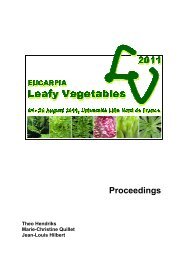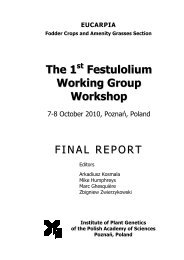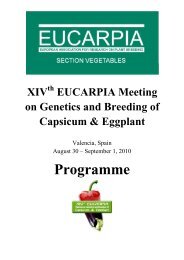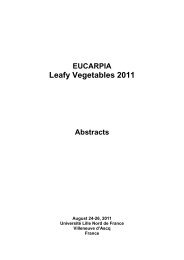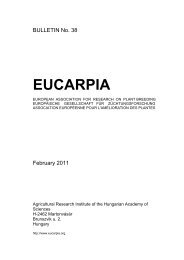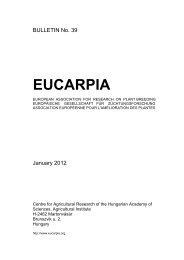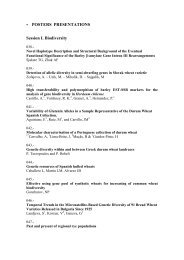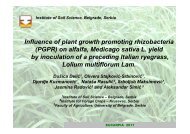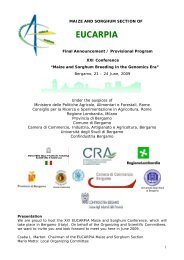Plant breeding for organic and sustainable, low-input agriculture
Plant breeding for organic and sustainable, low-input agriculture
Plant breeding for organic and sustainable, low-input agriculture
Create successful ePaper yourself
Turn your PDF publications into a flip-book with our unique Google optimized e-Paper software.
Quantifying genotype <strong>and</strong> environment interactions to benefit selection <strong>and</strong> evaluation of<br />
cereals <strong>for</strong> competitiveness against weeds<br />
S.P. Hoad <strong>and</strong> C.F.E Topp<br />
Scottish Agricultural College, Edinburgh, Scotl<strong>and</strong>, UK.<br />
Traits <strong>for</strong> weed suppression are important in the selection of cereals <strong>for</strong> <strong>organic</strong> farming <strong>and</strong><br />
<strong>sustainable</strong> <strong>low</strong>-<strong>input</strong> <strong>agriculture</strong>. The environment, including both seasonal <strong>and</strong> management<br />
factors, has a significant impact on the ability of a genotype to suppress weeds.<br />
Selection <strong>and</strong> evaluation of new genotypes would benefit from a better underst<strong>and</strong>ing of the<br />
relative contributions of genetic variation <strong>and</strong> genotype x environment interactions on key plant<br />
traits <strong>and</strong> crop characteristics <strong>for</strong> weed suppression.<br />
This includes important measures such as: (1) an early prostrate habit at the start of tillering<br />
combined with a high leaf area index; (2) high shoot population density that is a function of plant<br />
number <strong>and</strong> the ability of a plant to produce <strong>and</strong> maintain tillers; (3) rapid early growth al<strong>low</strong>ing<br />
the crop to maintain a light interception lead over the rapidly growing weeds, <strong>and</strong> with an<br />
appropriate growth habit, shade newly emerging weeds <strong>and</strong> (4) increased plant height that adds<br />
to competitiveness at moderate to high plant population densities, as well as increasing tolerance<br />
to weeds.<br />
Generally, a high season-long crop ground cover is important. Crop ground cover integrates<br />
several plant <strong>and</strong> crop characteristics. In fact, ground cover is strongly influenced by genotype x<br />
environment x crop management interactions. High ground cover by the crop at the end of<br />
tillering is strongly correlated with weed suppression up to full canopy cover <strong>and</strong> even to harvest.<br />
The balance between different characteristics <strong>for</strong> weed suppression will determine the value of a<br />
genotype, <strong>for</strong> early, late <strong>and</strong> season-long weed control. It is clear that selection <strong>for</strong> genotypes<br />
should be considered in relation to climatic factors that affect both crop <strong>and</strong> weed growth.<br />
For plant breeders, selection <strong>and</strong> evaluation of genotypes should be based on an underst<strong>and</strong>ing<br />
the role of different characteristics in weed competition under <strong>organic</strong> farming or <strong>low</strong>-<strong>input</strong><br />
conditions.<br />
Genotypes <strong>for</strong> <strong>organic</strong> <strong>agriculture</strong> need to be more robust in both their percentage establishment,<br />
under contrasting conditions, <strong>and</strong> in their ability shade weeds, through increased ground cover,<br />
that is complemented by beneficial effects of increasing tiller production <strong>and</strong> plant height.<br />
26




